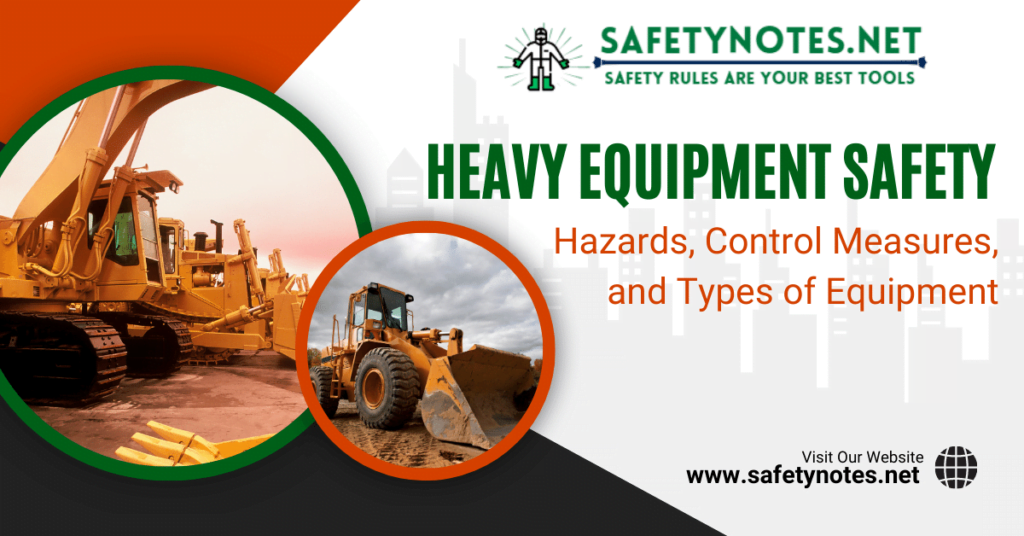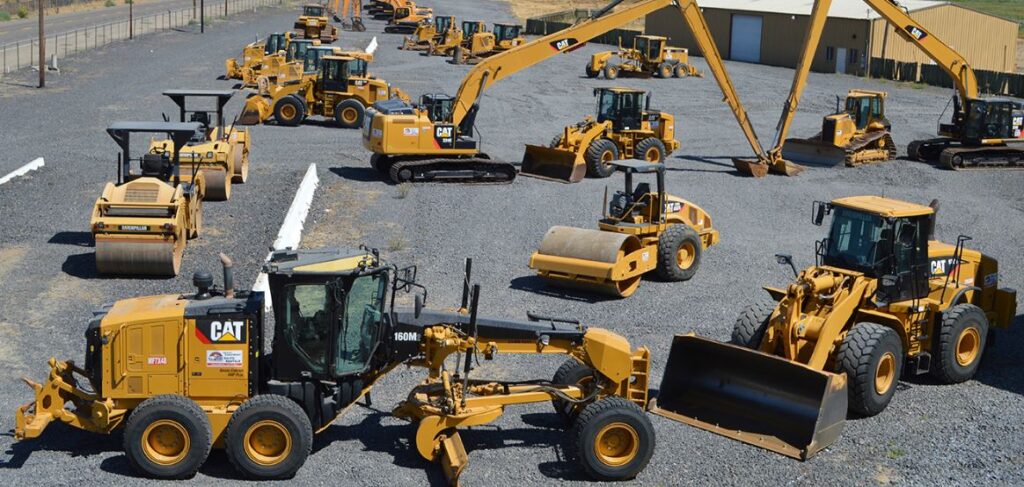
Heavy equipment plays a crucial role in various industries, enabling tasks that would otherwise be impossible or time-consuming. However, it is important to prioritize safety when operating heavy equipment to prevent accidents and protect lives. In this article, we will explore the hazards associated with heavy equipment, discuss effective control measures, and provide an overview of different types of equipment.
Hazards of Heavy Equipment
Operating heavy equipment involves working with powerful machinery, which presents several potential hazards. By understanding these hazards, we can take proactive measures to minimize the associated risks. Here are some common hazards associated with heavy equipment:
Moving Parts and Crush Hazards
Heavy equipment often consists of large moving parts such as rotating blades, tracks, and conveyor belts, which can pose a significant crush hazard. Operators and workers must be cautious and maintain a safe distance from these moving parts to avoid accidents.
Falling Objects and Striking Hazards
Improperly secured loads or unstable materials being lifted by heavy equipment can result in falling objects that pose a striking hazard. Operators and workers should wear appropriate personal protective equipment (PPE) and maintain a safe distance from the equipment during lifting and loading operations.
Electrocution Hazards
Heavy equipment relies on electrical systems to function properly. Operators should be aware of the risks associated with working near power lines, underground cables, or electrical installations. Insulated tools and proper training can help mitigate the risk of electrocution.
Noise and Vibration Hazards
Working with heavy equipment often involves prolonged exposure to high levels of noise and vibrations, which can lead to hearing loss, musculoskeletal disorders, and fatigue. Wearing hearing protection and taking regular breaks can mitigate these hazards.
Fire and Explosion Hazards
Heavy equipment that operates with flammable fuels, hydraulic fluids, or lubricants poses a risk of fire or explosion. Routine inspections, proper storage of flammable substances, and adherence to safety protocols help prevent these incidents.
Pinch Hazards
Heavy equipment may have mechanisms or parts that can pinch body parts if operators or workers come into contact with them. Awareness and adherence to safety protocols can prevent such accidents.
Visibility Hazards
Limited visibility from the operator’s cabin can lead to accidents. The use of mirrors and additional safety devices, along with proper positioning and signaling, improves visibility and reduces the risk of collisions.
Lack of Training and Inadequate Maintenance
Insufficient operator training and inadequate maintenance of heavy equipment, such as a wheelie bin tippers, contribute to safety hazards.
Comprehensive training programs and regular inspections and maintenance routines are essential to ensure safe equipment operation.
Control Measures for Heavy Equipment Safety
To mitigate the hazards associated with heavy equipment, several control measures should be implemented. These measures aim to protect equipment operators and those working in close proximity. Here are effective control measures for heavy equipment safety:
Operator Training and 3rd party Certification
Comprehensive training programs should be provided to operators to ensure they possess the necessary skills and knowledge to operate the equipment safely. Certification programs validate an operator’s competency, and ongoing training keeps them updated on safety practices.
Construction License and Third-Party Certification
For crane/boom truck/forklift operations, the equipment operator should have a valid construction license as per country and client regulation.
Equipment Inspection and Maintenance
Regular inspections and maintenance routines help identify and address potential issues with heavy equipment. Operators should conduct pre-shift inspections to check for any signs of wear, damage, or malfunction. Timely repairs and maintenance tasks should be carried out by qualified technicians.
Safety Certificate Validity
Heavy equipment should have a safety certificate issued by an equipment inspector or safety personnel. The validity period of the certificate may vary depending on client requirements. In live plants such as oil and gas facilities, safety certificates are mandatory to ensure equipment safety. For example, the safety certificate validity for KNPC (Kuwait National Petroleum Company) is usually three months, but it may differ depending on the client.
Personal Protective Equipment (PPE)
Operators and workers must wear appropriate PPE when working with heavy equipment. This includes items such as hard hats, high-visibility vests, safety glasses, gloves, and steel-toed boots. PPE serves as a barrier between the operator and potential hazards, reducing the risk of injuries.
Clear Communication and Signaling
Effective communication is crucial when working with heavy equipment. Operators should have clear signals and communication protocols established with ground personnel to ensure safe maneuvering and operations. Visual and audible warnings enhance safety on the worksite.
Trained Signalman / ???? Flagman
When operating heavy equipment, having a trained signalman with proper signaling flags is crucial. Clear and effective communication between the operator and the signalman helps ensure safe equipment maneuvering and prevents accidents.
Blind Spot Prevention
Equipment cabins should be designed to minimize blind spots. Adequate mirrors and additional safety devices improve visibility and reduce the risk of accidents caused by limited visibility.
Approved Spark Arrest
In environments with flammable materials or in live plants like refineries, the installation of approved spark arrest devices, marked with USDA marking, should be mandatory. These devices prevent sparks from the equipment that could potentially ignite flammable substances.
Fire Extinguishers
Heavy equipment should be equipped with fire extinguishers to respond promptly to fire incidents. The number of fire extinguishers required may vary based on client requirements and local regulations.
Proper Attire and Mirrors
Operators should refrain from wearing loose clothing that may get entangled with the equipment’s control levers. Additionally, the use of rearview and side-view mirrors helps improve visibility and awareness of the equipment’s surroundings.
Seat Belt Usage
Operators should always wear seat belts while operating heavy equipment. Seat belts help protect operators in the event of sudden stops, collisions, or equipment overturning.
Three-Point Rule for Mounting and Dismounting
The three-point rule should be followed when mounting or dismounting heavy equipment. This means having three points of contact with the equipment (e.g., two hands and one foot or two feet and one hand) to maintain stability and prevent falls.
Refueling Safety
When refueling heavy equipment at the site, it is crucial to switch off the engine and ensure no hot work is being conducted within a specific radius. Bonding and grounding should be done before refueling to prevent static electricity buildup. A separate permit should be obtained for equipment refueling.
Third-Party Certification and Calibration
Certain heavy equipment, such as cranes, boom trucks, and forklifts etc should undergo third-party certification to ensure compliance with safety standards. Calibration certificates for pressure safety valves (PSV) of air compressors should be obtained to verify their accuracy and functionality.
Hot Work Permit
In live plants like refineries, a hot work permit should be obtained before performing any hot work activities near or on heavy equipment. This permit ensures that necessary precautions are taken to prevent fire or explosion hazards.
Safe Loading and Unloading
When loading and unloading materials or objects, operators should follow safe procedures to prevent injuries. This includes using appropriate equipment and techniques, securing the load properly, and ensuring that the equipment is on stable ground.
Avoid Unexpected Start-Up
Operators should never leave heavy equipment unattended without properly securing it. Unexpected start-up can occur if someone inadvertently activates the equipment, leading to accidents or injuries. Operators should engage the parking brake, lower attachments, and turn off the engine before leaving the equipment.
Knowledge and Obeying Load Limits
Each piece of heavy equipment has specific load limits that should be strictly adhered to. Operators should be knowledgeable about these limits and avoid exceeding them. Overloading equipment can compromise its stability and lead to accidents.
Recognizing Physical and Emotional Limits
Operators should be aware of their physical and emotional limits when operating heavy equipment. Fatigue, stress, and distractions can impair judgment and increase the risk of accidents. It is important to take breaks, manage stress, and stay focused while operating heavy equipment.
Creating Buffer Zones
Creating buffer zones around heavy equipment can help prevent unauthorized personnel from entering hazardous areas. Clear signage and physical barriers should be used to mark these zones and restrict access.
Identifying and Marking Danger Zones
Identifying and marking danger zones around heavy equipment is essential to alert operators, workers, and pedestrians to potential hazards. This includes areas where the equipment has limited visibility or where specific operations pose a higher risk.
Work Zone Management
Proper planning and management of work zones are essential to prevent accidents involving heavy equipment. Designated pathways, barriers, and signage should be in place to guide the movement of equipment and personnel. Traffic control measures minimize the risk of collisions or incidents involving pedestrians and other vehicles.
Equipment Intended Purpose
Heavy equipment should only be used for its intended purpose. Using equipment for tasks it is not designed for can increase the risk of accidents and equipment failures. Operators should follow manufacturer guidelines and avoid improvising equipment usage.
Familiarity with Operator Manual
Operators should be familiar with the operator manual specific to the equipment they are operating. The manual provides essential information on safe operation, maintenance requirements, and troubleshooting. Operators should refer to the manual whenever needed and follow the manufacturer’s instructions.
Excavation Safety
Maintaining a safe distance from the edge of an excavation is essential to prevent cave-ins and protect workers from being buried. This distance should be strictly maintained during excavation operations.
Boom Safety
To prevent accidents, operators should never allow anyone underneath the boom of heavy equipment. This precaution helps avoid potential injuries caused by falling objects or accidental movements of the boom.
Air Compressor Safety
For air compressors, it is essential to have a hydro test certificate for the air receiving drum if the certificate’s validity exceeds five years as per KNPC (this tule can be differ client to client). Weep lash arrest devices for air compressor hoses, along with proper couplings, should be in place to prevent hose lashings and potential hazards.
Compactor Safety
For compactors, it is important to ensure that the on/off switch functions properly
and that there are no leakages. Employees operating compactors should wear ear muffs to protect against excessive noise exposure.
De-energizing Energy Sources
Whenever possible, operators should de-energize energy sources, such as electrical or hydraulic systems, when performing maintenance or repair tasks. This helps prevent accidental activations and ensures the safety of operators and maintenance personnel.

Types of Heavy Equipment
There is a wide range of heavy equipment available, each designed for specific tasks and industries. Here are some common types of heavy equipment:
Sure! Here are some types of heavy equipment along with their usage:
Loader
Loaders are versatile machines used for a variety of tasks, such as lifting, carrying, and loading materials. They are commonly used in construction, agriculture, and mining industries.
Grader
Graders are primarily used in road construction and maintenance projects. They are equipped with a long blade that helps level the ground, create slopes, and remove debris.
Excavator
Excavators are known for their digging and excavation capabilities. They are equipped with a bucket attached to a hydraulic arm, making them ideal for tasks such as digging trenches, demolishing structures, and moving heavy materials.
Concrete Mixer
Concrete mixers are used to blend cement, water, and aggregates to create concrete. They are essential in construction projects where a large volume of concrete is required.
Crane and Boom Trucks/Dump Trucks
Cranes and boom trucks are designed for lifting and moving heavy objects and materials. They are commonly used in construction sites, warehouses, and shipping yards. Dump trucks, on the other hand, are used for transporting loose materials such as soil, gravel, or debris.
Forklift
Forklifts are widely used for material handling and warehouse operations. They have forks at the front that can be raised and lowered to lift and move pallets, crates, and other heavy loads.
JCB/Wheel Loader
JCB or wheel loaders are versatile machines equipped with a front-mounted bucket. They are used for various tasks such as loading materials, backfilling, and excavating. Their wheels provide maneuverability and make them suitable for different terrains.
Bobcat/Compact Loader
Bobcat or compact loaders are small, maneuverable machines used for tasks such as landscaping, snow removal, and light construction work. They are highly versatile and can be equipped with various attachments for different applications.
Air Compressor
Air compressors are used to generate compressed air for powering pneumatic tools and equipment. They are essential in construction, manufacturing, and automotive industries.
Plate/Jaw/Roller Compactor
Compactors are used to compress and compact soil, asphalt, or other materials. Plate compactors, jaw compactors, and roller compactors are specifically designed for different types of compaction tasks.
Feller Buncher
Feller bunchers are specialized forestry machines used for cutting and gathering trees. They are commonly used in logging operations to efficiently clear trees and prepare them for further processing.
These are just a few examples of the various types of heavy equipment available. Each type serves specific purposes and is designed to handle different tasks in industries such as construction, mining, forestry, and more.
Conclusion
Heavy equipment safety should be a top priority in industries that rely on these powerful machines. By understanding the hazards, implementing effective control measures, and adhering to safety guidelines, companies can significantly reduce the risk of accidents and injuries in the workplace. Proper operator training, equipment inspection and maintenance, personal protective equipment usage, clear communication, and adherence to load limits are essential for ensuring heavy equipment safety. Additionally, measures such as seat belt usage, the three-point rule for mounting and dismounting, safe loading and unloading, and recognizing physical and emotional limits further enhance safety. By prioritizing heavy equipment safety, we can create a safer working environment and protect the well-being of operators, workers, and everyone involved in heavy equipment operations.
Frequently Asked Questions about Heavy Equipment
- Q: How important is heavy equipment safety?
- A: Heavy equipment safety is crucial for preventing accidents, injuries, and fatalities in industries that rely on these machines.
- Q: What are the main hazards of heavy equipment?
- A: The main hazards include moving parts and crush hazards, falling objects and striking hazards, electrocution hazards, noise and vibration hazards, fire and explosion hazards, pinch hazards, crush and pinch hazards, vibration hazards, visibility hazards, lack of training, and inadequate maintenance.
- Q: How can I ensure heavy equipment safety in my workplace?
- A: Implementing measures such as operator training, equipment inspections, personal protective equipment usage, clear communication, work zone management, approved spark arrest, safety certificate validity, fire extinguishers, third-party certification and calibration, hot work permit, construction license and third-party certification, blind spot prevention, trained signalman, excavation safety, boom safety, proper attire and mirrors, air compressor safety, refueling safety, compactor safety, seat belt usage, the three-point rule for mounting and dismounting, safe loading and unloading, avoiding unexpected start-up, knowledge and obeying load limits, recognizing physical and emotional limits, creating buffer zones, identifying and marking danger zones, using equipment for its intended purpose, being familiar with operator manuals, and de-energizing energy sources contribute to heavy equipment safety.
- Q: What are some examples of heavy equipment?
- A: Examples include excavators, bulldozers, cranes, forklifts, dump trucks, loaders, graders, backhoes, pile drivers, and skid-steer loaders.
- Q: Where can I learn more about heavy equipment safety?
- A: You can find valuable resources and guidelines from industry associations, regulatory agencies, and safety training organizations.



Thanks for sharing such a safety guide. We are a construction equipment supplier company from Australia. I appreciate your guide.
welcome dear
Safety is very important for heavy construction equipment. Heavy machinery is a term used to describe heavy-duty vehicles that are specifically made for carrying out construction jobs, most often those involving earthmoving or other sizable construction chores. Thanks for sharing this blog this is very Knowledgeable.
Thanks for sharing.